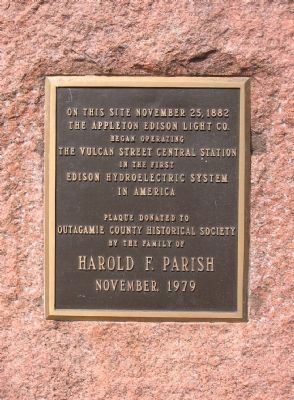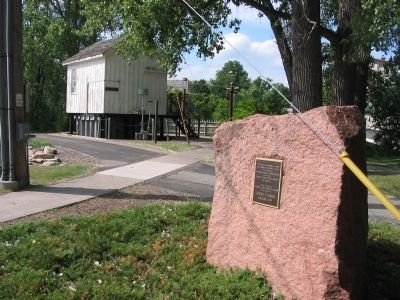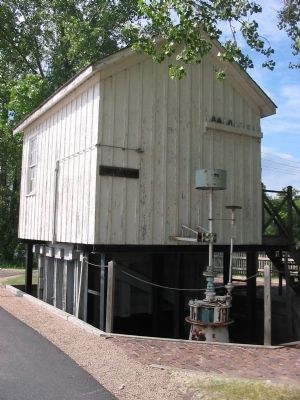Appleton in Outagamie County, Wisconsin — The American Midwest (Great Lakes)
First Edison Hydroelectric System in America
Plaque donated to Outagamie County Historical Society by the family of Harold F. Parish November, 1979
Erected 1979 by the family of Harold F. Parish.
Topics and series. This historical marker is listed in this topic list: Industry & Commerce. In addition, it is included in the ASCE Civil Engineering Landmarks, the Daughters of the American Revolution, the Historic Mechanical Engineering Landmarks, and the IEEE Milestones in Electrical Engineering and Computing series lists. A significant historical date for this entry is September 30, 1882.
Location. 44° 15.47′ N, 88° 23.836′ W. Marker is in Appleton, Wisconsin, in Outagamie County. Marker can be reached from South Lawe Street, on the right when traveling south. The plaque is located on South Vulcan Street, north of East South Island Street. Touch for map. Marker is at or near this postal address: 530 South Vulcan Street, Appleton WI 54915, United States of America. Touch for directions.
Other nearby markers. At least 8 other markers are within one mile of this marker, measured as the crow flies. Vulcan Street Plant Replica (here, next to this marker); 9-11 Memorial (about 500 feet away, measured in a direct line); The Merging of Milwaukee-Downer and Lawrence Colleges (approx. ¼ mile away); Lawrence University (approx. ¼ mile away); First Commercially Successful Electric Street Railway (approx. 0.4 miles away); Henry James and Cremora Rogers Residence (approx. 0.9 miles away); Number 736 (approx. one mile away); Soldiers and Sailors Memorial Bridge (approx. one mile away). Touch for a list and map of all markers in Appleton.
More about this marker. This plaque says November 25th but all other literature, and the missing Wisconsin Historical Society official historical marker, say that September 30th was the day the hydro-electric plant first began running.
Regarding First Edison Hydroelectric System in America. After a fire destroyed the central station, a replica was constructed at the current Lawe Street location preserving all of the building's original features. This building is currently located near its original location at the south end of the Lawe Street Bridge.
There are plans to relocate the replica to a new home in Vulcan Heritage Park, which is situated right across from the original Vulcan Plant.
Also see . . . Vulcan Street Power Plant. “On September 30, 1882, an Edison ‘K’ type dynamo produced electricity from a water-powered turbine to light three buildings (two paper mills and the H.J. Rogers home), at rate of about 12½ kilowatts. It is the first Edison hydroelectric central station to serve a system of private and commercial customers in North America. The story of its development provides keen insight into the nation’s first experiences with the electric light.” (Submitted on July 16, 2009.)
Additional keywords. Vulcan Street Plant; Mechanical Engineering Landmark #29
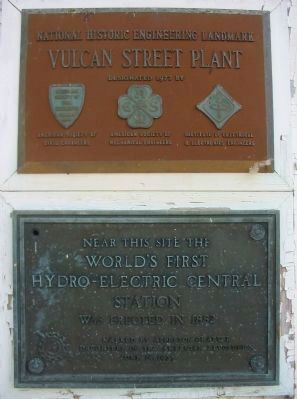
Photographed By Keith L, July 4, 2009
4. Plaques on Building
Top plaque: National Historic Engineering Landmark, Vulcan Street Plant designated 1977 by American Society of Civil Engineers, American Society of Mechanical Engineers and Institute of Electrical & Electronic Engineers.
Bottom plaque: Near this site the World’s First Hydro-Electric Central Station was erected in 1882. Marked by Appleton Chapter, Daughters of the American Revolution June 14, 1955.
Bottom plaque: Near this site the World’s First Hydro-Electric Central Station was erected in 1882. Marked by Appleton Chapter, Daughters of the American Revolution June 14, 1955.
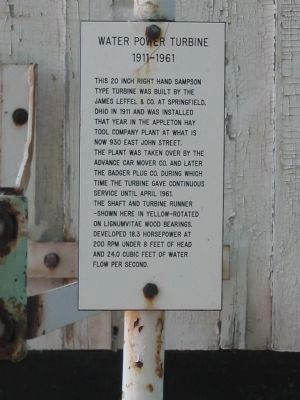
Photographed By Keith L, July 4, 2009
5. Water Power Turbine, 1911–1961
This 20-inch right-hand Sampson type turbine was built by the James Leffel & Com. at Springfield, Ohio, in 1911 and was installed that year in the Appleton Hay Tool Company plant at what is now 930 East John Street. The plant was taken over by the Advance Car Mover Co. and later the Badger Plug Co. during which time the turbine gave continuous service until April 1961. The shaft and turbine running—shown here in yellow—rotated on lignumvitae wood bearings. Developed 18.3 horsepower at 200 RPM under 8 feet of head and 24.0 cubic feet of water flow per second.
Credits. This page was last revised on August 28, 2020. It was originally submitted on July 16, 2009, by Keith L of Wisconsin Rapids, Wisconsin. This page has been viewed 1,575 times since then and 127 times this year. It was the Marker of the Week November 17, 2019. Photos: 1, 2, 3, 4, 5. submitted on July 16, 2009, by Keith L of Wisconsin Rapids, Wisconsin. • Craig Swain was the editor who published this page.
